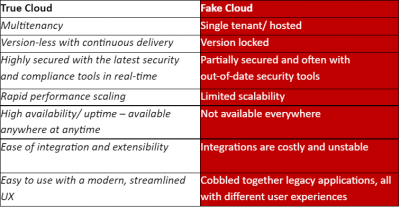True Cloud vs Fake (Hosted) Cloud: What’s the Difference and Why it Matters
True Cloud vs Fake (Hosted) Cloud: What’s the Difference and Why it Matters

So, you’ve decided it’s time to take your WFO solution to the cloud. That’s a smart choice—and one that puts business first rather than drain focus on IT infrastructures.
But pause before you purchase because not all software offerings are created equal. There are many WFO providers marketing themselves as “cloud,” but who are not actually true cloud solutions. Jumping at the chance to generate an additional revenue stream, many on-premises vendors proclaim that they offer cloud applications without anything to back it up.
How do you spot the difference between true cloud and fake cloud solutions? And more importantly, why does it matter?
Examples of True Cloud Capabilities

Let’s learn more about each one and why it’s important.
Key Cloud Capability: Multitenancy
In true cloud, there is one instance of the platform that serves all customers or “tenants” simultaneously, across a shared infrastructure. Just like in an apartment building, controls in the underlying code keep the tenants separate—you get your own unique, secure unit or tenant. This pooling of resources is what achieves true cloud agility and scalability.
In a fake cloud, the solution is actually built on a multi-instance platform. In this scenario, each customer or tenant receives its own server. To scale up, new servers must be switched on manually which is costly, time-consuming, and difficult to maintain. To get the latest functionality, the latest software must be installed separately for each instance, significantly delaying your ability to benefit from new features.
Even worse, some fake clouds put multiple customers on the same server and rely on organizational structure alone to keep them segregated; this is not multitenancy, it is shared tenancy and may require some features to be off-limits because the tenants would be able to see each other’s data.
Key Cloud Capability: Continuous Delivery
In true cloud, your applications are continuously updated with new functionality and bug fixes. You can continue to use your application, without any downtime during these updates. Users can easily adapt to the incremental changes.
In a fake cloud, you will have several big and potentially risky updates occur a few times per year. Until your vendor schedules upgrades to your environment, these bugs and issues will be pervasive for many months, disrupting your operation with significant downtime and team members needing additional time to learn about these changes.
Key Cloud Capability: Security
In true cloud, your data is secured with the latest security tools, updates, and patches in real-time without added cost or downtime. True clouds are hosted on the leading global cloud service providers such as AWS and Azure where security is their highest priority, having nearly any certification you can think of and employing an unmatched army of experts.
In a fake cloud, there is no unified security among all applications and platforms. Vendors that provide fake clouds simply cannot achieve the same level of security and expertise as Amazon Web Services and Microsoft Azure.
A fake cloud with fake multitenancy also means that providers need to defend hundreds of fortresses at the same time, instead of just one. This dilutes the time and attention that is being paid to defending your data from attack.
Key Cloud Capability: Rapid performance scaling
In true cloud, you can easily scale up or down to meet the needs of your business. True cloud solutions are built to handle rapid change seamlessly, allowing you to quickly expand your system as needed, all while easily meeting the needs of a highly mobile and global workforce.
In a fake cloud, the vendor must have the necessary staff and hardware available to manually increase capacity or deploy new capabilities. This often requires specific technical expertise or pricey professional services which is problematic and can lead to downtime, delays in service, and reduced speed to benefit – especially when deploying in multiple time zones and geographies – all of which could negatively impact customer satisfaction.
Key Cloud Capability: High Availability/Uptime
In true cloud, you get a guaranteed uptime and reliability and are financially compensated if service levels are not met. You can rest easy knowing that your data is securely backed up and always available.
Even if disaster strikes one data center, another one immediately takes over with no downtime or hassle for you. All this is possible because true cloud solutions leverage multitenant architecture and are built in the cloud with cloud infrastructure in mind.
In a fake cloud, availability is limited by the vendor, the hardware on which their solution is installed, and who is maintaining it. Since it is often outsourced to a third-party vendor, you may not even know who is ensuring the availability of your mission-critical solutions.
Key Cloud Capability: Ease of integration and extensibility
In true cloud WFO solutions, you can easily integrate with both cloud and on-premises solutions. True cloud solutions provide the flexibility to meet your unique business needs so integrating with external systems is straightforward, seamless, and low effort
In a fake cloud, integration and customization become expensive hassles that can be unstable. Hosted cloud solutions are not inherently designed for ease of integration and can end up being expensive to implement and maintain as well.
Key Cloud Capability: Easy to use
In true cloud, applications are designed with User Experience in focus. Modern web-based user interfaces make onboarding new users easier, thanks to increased access to all functionality features. Centralized management and administration make the true cloud WFO easy to administrate, especially if you’re a multi-site or global organization. This is only possible if your WFO suite is fully integrated with all your sites being managed from a single, centralized management console.
In fake cloud, this can be a hodgepodge with some applications even requiring administrators to install and login to a desktop application. User experience will be bad, and users will have to learn multiple different user interfaces. If you’re a multi-site organization with multiple types of ACDs and integrations, be prepared for a maintenance and security nightmare.
So, not all clouds are created equal. Here is a set of questions to ask your vendor to find out if they will provide you with a true or fake cloud
- How often do you provide updates and new functionality?
- Will I have downtime when you update my tenant?
- In my tenant, will my data be totally isolated from other tenants?
- Will I have downtime when you update other customers in your cloud?
- How often are your security tools updated?
- How quickly did you fully remediate your customers when the Log4J vulnerability was announced?
- Do you have a Service Level Agreement (SLA), and what happens if it is not met?
- Is there a single user interface for your WFO suite?
Don’t let vendors pull the cloud over your eyes. Get in touch with our team for more information.









